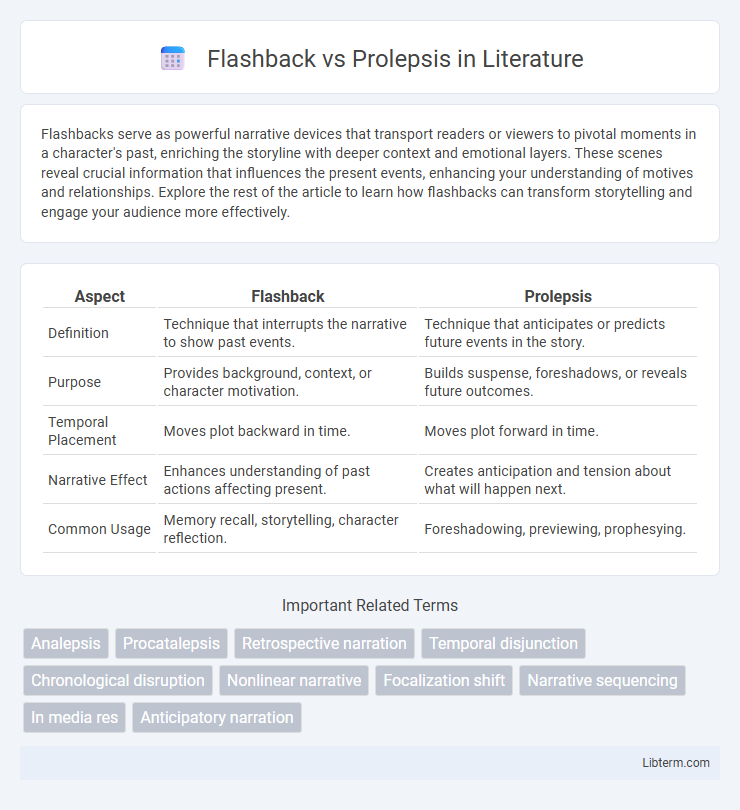Flashbacks serve as powerful narrative devices that transport readers or viewers to pivotal moments in a character's past, enriching the storyline with deeper context and emotional layers. These scenes reveal crucial information that influences the present events, enhancing your understanding of motives and relationships. Explore the rest of the article to learn how flashbacks can transform storytelling and engage your audience more effectively.
Table of Comparison
| Aspect | Flashback | Prolepsis |
|---|---|---|
| Definition | Technique that interrupts the narrative to show past events. | Technique that anticipates or predicts future events in the story. |
| Purpose | Provides background, context, or character motivation. | Builds suspense, foreshadows, or reveals future outcomes. |
| Temporal Placement | Moves plot backward in time. | Moves plot forward in time. |
| Narrative Effect | Enhances understanding of past actions affecting present. | Creates anticipation and tension about what will happen next. |
| Common Usage | Memory recall, storytelling, character reflection. | Foreshadowing, previewing, prophesying. |
Understanding Flashback: Definition and Purpose
Flashback is a narrative device that interrupts the chronological flow of a story to depict events that occurred prior to the current timeline, enriching character backstories and deepening plot understanding. This technique provides essential context that explains motivations and subsequently influences the narrative's present developments. Filmmakers and authors utilize flashbacks to reveal hidden information, create dramatic tension, and enhance emotional engagement by connecting past experiences directly to characters' current actions.
Defining Prolepsis: Meaning and Usage
Prolepsis, a narrative technique, involves the insertion of scenes or events that occur in the future relative to the current timeline, serving to anticipate or forecast forthcoming developments. It functions to create suspense, foreshadow outcomes, or provide deeper insight into character motivations by revealing future actions or consequences. In literature and film, prolepsis contrasts with flashback by moving the narrative forward rather than backward, enriching the storytelling structure through temporal shifts.
Structural Differences: Flashback vs Prolepsis
Flashback structurally interrupts the chronological flow of a narrative by inserting past events to provide background or context, often marked by time shifts or cues like "years ago." Prolepsis, or flashforward, projects future events ahead of the current timeline, creating anticipation or foreshadowing through narrative cues such as "later that day" or "in the future." The primary structural difference lies in their temporal placement: flashbacks move the narrative backward, while prolepsis advances it forward.
Narrative Impact of Flashback
Flashback enriches narrative depth by providing essential background information that shapes character motivations and plot development, creating a more immersive and emotionally resonant experience. It interrupts chronological storytelling to reveal past events, thereby enhancing readers' understanding of current conflicts and foreshadowing future outcomes. This technique contrasts with prolepsis, which projects future occurrences, but flashback's strength lies in its ability to contextualize and deepen the present narrative moment.
How Prolepsis Shapes Storytelling
Prolepsis shapes storytelling by allowing writers to present future events or outcomes early in the narrative, creating suspense and foreshadowing crucial plot developments. This technique engages readers by offering glimpses of what is to come, influencing their interpretation of the story's present actions. In contrast to flashbacks, which reveal past events, prolepsis drives narrative momentum forward, enhancing thematic depth and emotional impact.
Examples of Flashback in Literature and Film
Flashback, a narrative technique that interrupts the present storyline to depict past events, is prominently used in literature such as Marcel Proust's "In Search of Lost Time," where detailed reminiscences reveal character motivations. In film, "The Godfather Part II" utilizes flashbacks to explore Vito Corleone's early life, blending past and present to deepen the protagonist's backstory. This method contrasts with prolepsis, which foreshadows future events, underscoring flashback's role in enriching narrative depth through retrospective insight.
Effective Use of Prolepsis in Narratives
Prolepsis, or flash-forward, enhances narrative tension by revealing future events, creating anticipation and emotional engagement. Strategic placement of prolepsis deepens character development and plot complexity, encouraging active reader interpretation. Effective use of prolepsis can contrast with flashbacks to balance past and future, enriching storytelling dynamics in literature and film.
Reader Engagement: Flashback versus Prolepsis
Flashback immerses readers by revealing past events that shape characters' motives, enhancing emotional depth and context, which deepens engagement through nostalgia and understanding. Prolepsis propels reader curiosity by teasing future occurrences, building suspense and anticipation that maintains a forward-driving narrative. Balancing both techniques strategically enriches storytelling, keeping readers invested through dynamic temporal shifts.
Integrating Flashback and Prolepsis Seamlessly
Integrating flashback and prolepsis seamlessly enhances narrative flow by strategically placing past and future events to enrich character development and plot coherence. Effective transitions between timelines rely on clear temporal markers and consistent verb tenses, preventing reader confusion while maintaining engagement. Utilizing sensory details and emotional triggers during flashbacks or prolepses deepens immersion and strengthens thematic connections across the story.
Choosing the Right Technique for Your Story
Selecting between flashback and prolepsis depends on the narrative's temporal structure and the impact desired on readers. Flashbacks enrich storytelling by revealing past events that clarify character motivations or plot developments, while prolepsis, or foreshadowing, builds suspense by hinting at future occurrences. Understanding the pacing and thematic relevance ensures the chosen technique enhances narrative tension and emotional resonance.
Flashback Infographic

 libterm.com
libterm.com